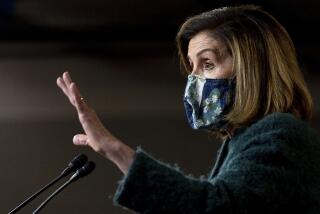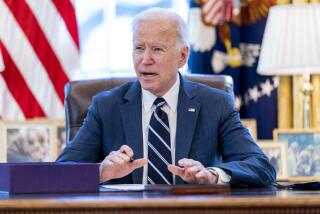Trimming the lifelines
Ayear ago, President-elect Barack Obama was confronted with a fast-sinking economy, mounting unemployment and a wave of mortgage defaults that threatened to oust millions of people from their homes. The country seems to be pointed in the other direction today, thanks in part to a $787-billion economic stimulus package that Congress passed in February at Obama’s urging. Nevertheless, the double-digit unemployment rate threatens to keep the economy limping for several years. Consumers are far more confident than they were in December 2008, but there is growing anxiety about Washington’s handling of the crisis -- the debt it’s amassing, its deep intervention into the auto, banking and housing industries, and the costs it may impose in the name of healthcare reform and climate change.
It’s not fair to hold Obama accountable for many of Washington’s actions on Wall Street, which were instigated by President Bush, former Treasury Secretary Henry M. Paulson Jr. and Federal Reserve Chairman Ben S. Bernanke. Yet by trying to rescue so many sectors of the economy while launching ambitious initiatives on multiple fronts, Obama has led the public to question his intentions as well as his focus. Is the president trying to guide the economy through a rough patch, or to increase government’s control over the private sector?
Nothing would quiet the second-guessers as effectively as a swift drop in unemployment. The chances of that happening, however, are just about nil. In fact, there are disquieting signs of weakness in the housing market that could renew consumers’ pessimism and lead to a second downturn. Obama is thus left to press ahead with an increasingly unpopular agenda -- including another multibillion-dollar stimulus package -- while trying to restore the public’s faith in his brand of change. He’ll never assuage his most conservative critics, but he’ll have more success if he offers a clearer plan for withdrawing from the rescue business and bringing the government’s finances under control after the economy has recovered.
A good place to start would be the $700-billion Troubled Asset Relief Program that Congress created late in 2008 in response to a freeze in the credit markets. TARP initially was designed to clear the distressed assets that were clogging banks’ balance sheets, but Bush’s Treasury Department used it to invest directly in scores of banks -- a practice that has continued to this day. The Treasury has also poured tens of billions into General Motors, Chrysler and their lending partner, GMAC; American International Group; and, through a separate piece of legislation, Fannie Mae and Freddie Mac.
We don’t quibble with the decisions to provide emergency aid, even for the automakers, which couldn’t have been restructured through bankruptcy without loans from Washington. But the investments create conflicts of interest among the government’s roles as policymaker, regulator and guardian of taxpayer dollars. Examples include Congress’ attempt to micromanage the decisions by GM and Chrysler to close dealerships and the administration’s use of Fannie and Freddie to finance more mortgages when other sources dried up. Such moves might advance a political agenda, but they aren’t good for the automakers or Fannie and Freddie.
The Treasury Department should articulate an exit strategy for all its TARP investments and other extraordinary capital infusions. Just as important, Washington needs a far better approach to companies that today are considered too big to fail. The current system of federal lifelines encourages irresponsible risk-taking by large companies, discriminates against small firms and enables the Treasury Department to pick winners and losers in the financial markets.
Some of the same problems have tainted Washington’s efforts to stimulate the economy. The recession clearly would have been worse without the American Recovery and Reinvestment Act, yet the slow deployment of dollars and the laundry list of programs have diluted its effect. Now Obama and congressional Democrats are pushing a second round, financed largely with TARP funds that banks have repaid. As problematic as the high unemployment rate may be, it’s still unnerving to consider an additional $154 billion in deficit spending before the administration has laid out a plan to solve the government’s long-term financial problems. Granted, the long-term troubles are more related to escalating healthcare costs and the aging population than the current outpouring of red ink. All the same, the public can’t help but wonder about the debt we’re building up. The administration should demonstrate to consumers and investors that huge deficits are stopgap measures, not a permanent realignment.
More to Read
Inside the business of entertainment
The Wide Shot brings you news, analysis and insights on everything from streaming wars to production — and what it all means for the future.
You may occasionally receive promotional content from the Los Angeles Times.










